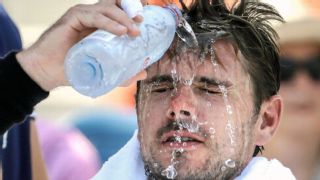|
NEW YORK -- The players who survived the dangerous heat and humidity that plagued the US Open on Tuesday and Wednesday now face a challenge that's less obvious but no less daunting: recovery. Not just recovering, but recovering sufficiently to find their A-games in the next round. That complicated task can affect the entire course of a tournament (top seeds Caroline Wozniacki, Novak Djokovic and Angelique Kerber were among the players most impacted by Tuesday's scorching heat), and it begins with replenishing body fluids. It includes techniques like ice baths and massage. Less obvious: the need to replace carbohydrates. And to do so quickly. "It's not even the days after, it's hours after," Dr. Melissa Leber, a player physician for the US Open and Director of Emergency Dept. Sports Medicine at The Mount Sanai Hospital, told ESPN.com. It's important to have a meal with high fat content, as well as to load up with carbs as soon as 30 minutes after a match, she said. Since most players would be hard-pressed to force down food so soon after a stressful match in the heat, liquid meals are the usual solution.  These remedial measures all help, as does shrewd tactical play during hot days. Mats Wilander, who won seven Grand Slam titles and reached the No. 1 ranking, told ESPN.com, "When it's that hot, you can't recover even with a day off if you go full out in a long match. So you have to find your way of dealing with it. If I felt that beating a guy playing full-on the way I would in normal conditions would hurt my chance to recover for my next match, I'd do something different. I'd try to win four-shot rallies instead of long ones. That might be my weakness, but I have to do it because if I don't I'm dead. There's no recovery possible if I pushed myself too hard." Wilander pointed out that today's generation isn't noted for having that kind of tactical and strategic flexibility. But Sloane Stephens -- one of the more versatile of today's players -- did allow after her three-set win on Wednesday that, "When it's that hot, you make some adjustments. Longer points are not the best. [You do] just little things, but I don't think you change your game too much because of the weather." Extreme-heat rules and the USTA's 10-minute break between sets three and four (instituted for the men for the first time this week) are intended to keep players safe -- and, presumably, able to continue in the tournament should they go on to win. But the rules' efficacy is a matter of some debate among the players. "I'm always laughing about the heat rule," Gilles Simon said on Wednesday, after losing to Milos Raonic. " 'All right, you can take 10 minutes at the end of the third set.' ... Thank you, man, that's nice." Simon suggested that the official who makes the rules should try playing on one of these brutally hot days. "Anyone who isn't on court can't understand the suffering. How it is to be there," Simon said. "How your brain is completely out [of it] sometimes. Of course that stays with you [if you survive to continue]." In general, the players feel that every little bit helps. Stephens, who was on court for two hours and 45 minutes, said she appreciated having a break at the end of the second set. "You are able to regroup, sit in the AC for a little bit, cool your body down. Tough conditions today, so the break was very helpful."  Leber said, "The core temperature doesn't come down dramatically. But taking that break does make athletes feel better and the temperature does come down a bit in that time." She also said that a change of clothing seems to help, as dry fabric aids evaporation. Wilander said he doesn't think the 10-minute break accomplishes much. But he's in favor of an extreme-heat policy that shuts down play outdoors and/or closes the roof on air-conditioned stadiums. The Australian Open, the only other Grand Slam tournament that has severe-heat issues, has such a policy. But it sets the bar for suspending matches so high that it experienced another heat-related controversy this year despite the policy being in place. "Ten minutes doesn't make sense to me," Wilander said. "A heat rule is fine, just stop it [play]. It's just three, four hours stoppage anyway. It's supposed to be a health hazard, so why not treat it like one?" Simon agreed: "I have the feeling that until something really bad happens, nothing is really going to change." ESPN's Aishwarya Kumar contributed to this story.
|
